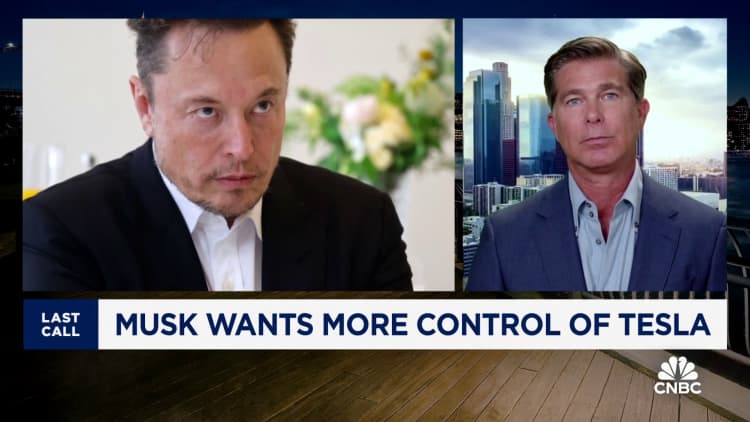Elon
Musk,
CEO
of
Tesla,
speaks
at
the
Atreju
political
convention
organized
by
Fratelli
d’Italia
(Brothers
of
Italy)
in
Rome,
Italy,
on
Dec.
15,
2023.
Antonio
Masiello
|
Getty
Images
Tesla
reported
revenue
and
profit
for
the
fourth
quarter
that
missed
analysts’
estimates
as
automotive
revenue
increased
just
1%
from
a
year
earlier.
The
stock
slid
almost
6%
in
extended
trading.
Here
are
the
key
numbers:
-
Earnings
per
share: 71
cents,
adjusted
vs.
74
cents
expected
by
LSEG,
formerly
known
as
Refinitiv. -
Revenue: $25.17
billion
vs.
$25.6
billion
expected
by
LSEG.
Total
revenue
increased
3%
from
$24.3
billion
a
year
earlier.
Operating
margin
for
the
quarter
came
in
at
8.2%,
down
from
the
year-ago
quarter’s
figure
of
16%
and
slightly
higher
than
7.6%
in
the
prior
quarter.
Meager
growth
in
auto
revenue
was
partly
due
to
a
reduced
average
selling
price
following
steep
price
cuts
around
the
world
in
the
second
half
of
the
year.
Net
income
for
the
quarter
more
than
doubled
to
$7.9
billion,
or
$2.27
per
share,
from
$3.7
billion,
or
$1.07
per
share,
a
year
earlier.
The
increase
was
mostly
due
to
a
$5.9
billion
one-time
noncash
tax
benefit.
Tesla
said
in
its
investor
presentation
that
vehicle
volume
growth
in
2024
“may
be
notably
lower”
than
last
year’s
growth
rate
as
the
company
works
toward
launching
its
“next-generation
vehicle”
in
Texas.
The
company
cautioned
investors
that
it’s
“currently
between
two
major
growth
waves.”
CEO
Elon
Musk
was
asked
on
the
earnings
call
if
investors
should
be
uncomfortable
with
his
stated
desire
to
own
25%
of
Tesla.
The
question
was
in
reference
to
a
recent
tweet,
in
which
Musk
said
that’s
how
much
voting
control
he
would
want
before
turning
Tesla
into
a
“leader
in
AI
and
robotics.”
Musk
responded
by
saying
he
doesn’t
want
to
be
in
the
position
to
be
“voted
out
by
some
sort
of
random
shareholder
advisory
board,”
and
he
floated
the
possibility
of
creating
a
dual-class
share
structure.
Musk
highlighted
proxy
advisory
firms
Institutional
Shareholder
Services,
or
ISS,
and
Glass
Lewis
as
groups
creating
challenges,
alongside
activists
that
“infiltrate”
companies
and
“have
strange
ideas
about
what
should
be
done.”
In
mentioning
ISS,
Musk
said
he
calls
the
group
“ISIS,”
referring
to
the
Islamic
State.
ISS
didn’t
immediately
respond
to
CNBC’s
request
for
comment.

watch
now
When
asked
about
the
timeline
for
production
of
Tesla’s
humanoid
robot,
called
Optimus,
executives
declined
to
give
any
specific
guidance.
Musk
described
Optimus
as,
“something
that
I
think
has
the
potential
to
far
exceed
the
value
of
everything
else
combined”
for
Tesla.
He
claimed
that
Tesla’s
technology
developed
in
its
automotive
unit
translates
well
to
the
humanoid
robot
“because
the
car
is
just
a
robot
on
four
wheels.”
Optimus
is
“by
far
the
most
sophisticated
humanoid
robot
that’s
being
developed
anywhere
in
the
world,”
Musk
added.
Competitors
in
the
market
include
Boston
Dynamics,
Agility
Robotics
and
Figure.
Other
robotics
companies
such
as
Sanctuary,
Apptronik,
1X,
Fourier
and
Unitree
are
all
working
on
dexterous
manipulation
hardware,
mimicking
human
hands.
Musk
said
Tesla
has
“got
a
good
chance
of
shipping
some
number
of
Optimus
units
next
year,”
but
he
didn’t
specify
their
capabilities
or
the
cost.
Musk
admitted
on
the
call
that
he
tends
to
be
optimistic
on
timelines.
Cybertrucks
hit
the
market
During
the
quarter,
Tesla
began
selling
Cybertrucks
to
customers.
The
company
said
in
its
investor
deck
that,
“We
expect
the
ramp
of
Cybertruck
to
be
longer
than
other
models
given
its
manufacturing
complexity.”
Tesla
said
it
now
has
the
capacity
to
build
more
than
125,000
of
the
vehicles
in
a
year.
On
the
earnings
call,
Musk
called
the
Cybertruck
“our
best
product
ever
and
a
“head-turner.”
“I
see
us
delivering
somewhere
on
the
order
of
a
quarter-million
Cybertrucks
a
year,”
he
said,
without
giving
a
precise
timeframe.
A
Tesla
Cybertruck
at
a
Tesla
store
in
San
Jose,
California,
on
Nov.
28,
2023.
Bloomberg
|
Bloomberg
|
Getty
Images
For
the
full
year,
Tesla
said
automotive
revenue
reached
$82.42
billion,
a
15%
increase
from
2022.
The
energy
division,
which
is
much
smaller
than
Tesla’s
core
business,
was
a
bright
spot,
with
revenue
rising
54%
to
$6.04
billion.
The
unit
sells
solar
energy
generation
and
energy
storage
systems.
Tesla’s
“Services
and
Other”
revenue
rose
37%
from
a
year
earlier
to
$8.32
billion.
Operating
income
decreased
year
over
year
to
$2.1
billion
in
the
quarter,
with
Tesla
blaming
the
declining
profits
on
the
reduced
average
sales
price
of
its
vehicles
and
an
increase
in
operating
expenses
“partly
driven
by
AI
and
other
R&D
projects.”
Spending
on
research
and
development
increased
to
$1.09
billion
from
$810
million
a
year
earlier,
though
it
was
down
from
$1.16
billion
in
the
prior
quarter.
In
its
shareholder
presentation,
Tesla
confirmed
that
it
had
rolled
out
a
new
version
of
its
premium
driver
assistance
software,
marketed
as
its
Full
Self
Driving
Beta
or
FSD
Beta
option.
The
software
doesn’t
make
Tesla’s
cars
autonomous,
as
they
still
require
an
attentive
driver
at
the
wheel.
As
of
the
end
of
2023,
Tesla
had
54,892
Supercharger
connectors
available
to
drivers
around
the
world
at
5,952
stations.
Tesla
shares
have
dropped
about
16%
so
far
this
year
as
of
Wednesday’s
close
after
more
than
doubling
in
2023.

watch
now
